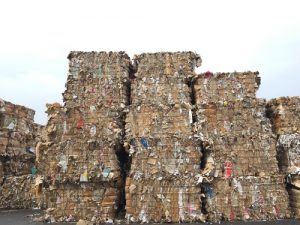
The basic reaction can be summed up by the Scooby-Doo-inspired words of one reader who posted the following to our LinkedIn page the day the story broke: “Ruh-roh.”
Ruh-roh is right. Clearly, we’re about to enter the next stage in recycling market uncertainty. And it could be spooky. Recycling companies and programs are scrambling to figure out how to best respond. It might make sense to take a step back and understand how the move fits into the Asian behemoth’s expansive, evolving economic strategy.
A buyer like no other
In detailing the ban, Chinese leaders noted “unsorted” paper and a host of key recovered plastic resins would be prohibited from import starting in late 2017.
If China closes the door completely on those materials, the repercussions will be astounding. According to recycled fiber market analyst Bill Moore, the U.S. industry exported around 4 million tons of materials in the mixed-paper grade in 2016 and roughly 60 percent of that total headed to Chinese buyers.
China is equally important on the plastics side. According to U.S. export statistics, China has been the largest overseas consumer of recovered PE, PS, PVC and PET every month this year. And all of those resins are included in the list of 24 segments of “solid wastes” outlined in the ban.
Given how much material heads to the country, it’s natural to wonder whether the action will actually come to pass. China has been taking in enormous tonnages of recyclables from the U.S. and elsewhere for decades for a reason: The nation needs feedstock to keep its manufacturing engine humming, and recovered paper, plastic and other materials have emerged as a cost-effective cog in that machine.
That’s why some recycling insiders aren’t exactly taking the ban language at face value.
“The real losers [from the ban] in addition to the recycling programs in the West are the Chinese mill companies,” Moore said. “They’re going to have real problems competitively in terms of their packaging and making boxes. And for that reason I don’t think China will go all the way on a mixed-paper ban.”
Sally Houghton of the PET-focused Plastics Recycling Corporation of California expressed similar sentiments in an interview. “I find it hard to believe that China is going to cut all imports,” she said, “because they rely so heavily on it and they manufacture so much of the plastic in the world.”
It’s also worth noting that plenty of questions remain about what Chinese authorities really mean by the different materials terms they noted in the ban announcement. One large materials recovery facility operator we spoke with had the impression that on the fiber side, the Chinese action would only affect paper that hadn’t been sorted at all and that the type of bale we in the U.S. refer to as “mixed paper” would actually continue to flow to Chinese mills without issue.
‘They keep on pushing’
What does seem clear, however, is that China is serious about leveraging its power in the global marketplace.
When China’s Green Fence import initiative was implemented in 2013, the U.S. recycling industry wondered whether it would just be a short-term effort on the part of customs inspectors. But the quality bar seems to have slowly and steadily raised since then.
The proposed ban is in many ways the next logical step for China to indicate to the world it wants us to deliver higher quality product. “They keep on pushing,” Moore said. “You can trace this all the way back to Green Fence.”
And in fact, China’s most recent play might be about more than guaranteeing clean feedstock for its mills and manufacturers. It also seems to be about shifting global perceptions of the country.
In an English-language statement regarding the import ban proposal, China’s government set out a target of growing domestic collection of recyclables to 350 million metric tons annually by 2020. That number is 42 percent higher than what China collected in 2015, according to the government document.
China sees its economic future as one of pushing outward, of not being merely a colossal consumer.
No longer is Beijing satisfied to just take in the rest of the world’s scrap. It wants to leverage its own resources. And it’s not far-fetched to imagine a time when the country starts exporting significant tonnages to other nations.
Recycling is not the only area where China is looking to rewrite its role in the global economic order. The New York Times this weekend ran an analysis on how Chinese authorities have strategically fostered partnerships between Qualcomm and other U.S. tech players to help ensure that more of the development of boundary-pushing computer chip technology happens within Chinese companies. This step would allow China to move away from simply being the place where electronics are assembled and instead help it drive the evolution of computing.
Similarly, China continues to push its hugely ambitious “One Belt, One Road” initiative, which is looking to infuse up to $1 trillion in infrastructure projects in dozens of countries across the world.
The takeaway from these developments is that China sees its economic future as one of pushing outward, of not being merely a colossal consumer. That makes perfect sense. The United States and other economic heavyweights of the last half century have all grown using that same approach – when a country shapes the development of any global industry, that country stands to gain considerably.
To be sure, in the near term, China will remain a large buyer of the materials collected and processed by U.S. recycling stakeholders. But companies and programs here should also expect the economic relationship with China to continue to morph as Beijing puts more global ambitions into action.
Colin Staub contributed reporting for this article.
More stories about Asia
- Study: Urban circularity requires tailored solutions
- ISRI recap: Exporters continue to face uncertainty
- Brands make sustainability moves, but use more plastic